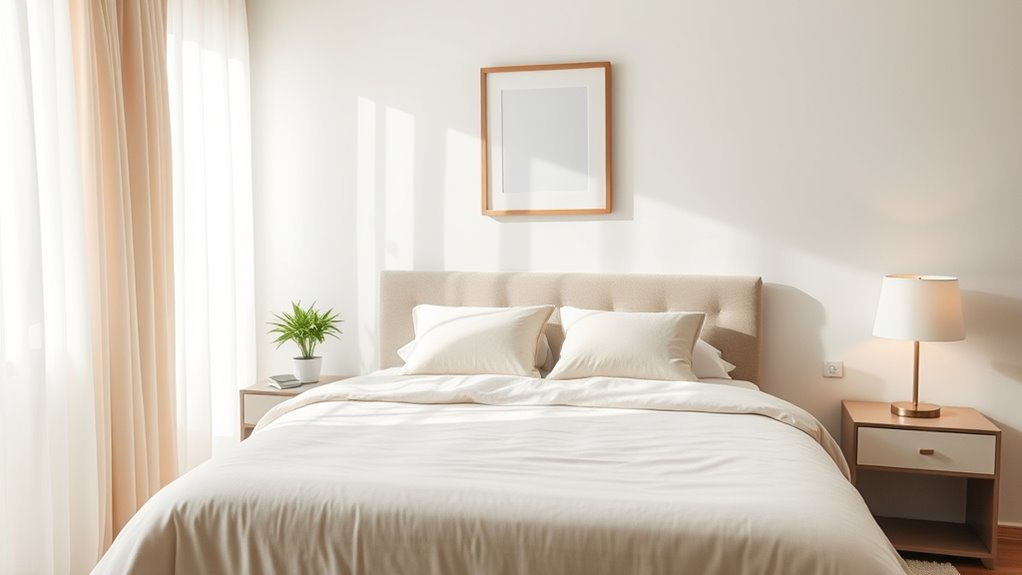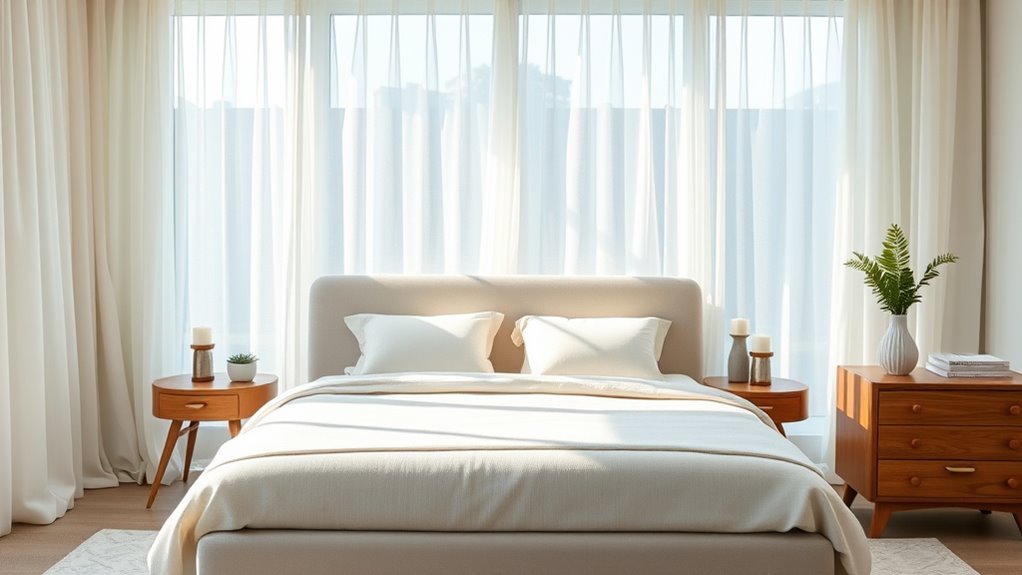To create a restful bedroom with Feng Shui, position your bed so you can see the door without being directly in line with it, and avoid placing it under windows or against shared walls. Use calming colors like soft blues or neutral tones, and incorporate natural elements like plants. Keep the space tidy and clutter-free to promote positive energy flow. Proper lighting and balanced decor foster a peaceful atmosphere. Understanding these principles will help you craft a serene retreat that encourages deep, restful sleep.
Key Takeaways
- Position the bed in a commanding spot with a clear view of the door, avoiding alignment with windows or shared walls.
- Use calming colors like soft blues, greens, or neutrals, accented with vibrant pillows or artwork for balance.
- Maximize natural light with gentle window treatments that soften sunlight without blocking it entirely.
- Keep the space clutter-free and incorporate natural elements such as plants or calming artwork to promote positive energy.
- Arrange furniture thoughtfully to create a safe, stable environment that fosters relaxation and restful sleep.

Creating a restful bedroom starts with understanding Feng Shui principles that promote balance and tranquility. One of the most important aspects is bed placement. You want to position your bed in a commanding spot, ideally where you can see the door without being directly in line with it. This “command position” makes you feel secure and in control, reducing stress when you wake up. Avoid placing the bed under a window or directly against a wall that shares a bathroom or closet, as these can disrupt energy flow and create unease. If possible, keep the bed away from heavy furniture or sharp corners that might generate negative energy. Using a sturdy headboard is also recommended; it provides support and a sense of stability, which are crucial for restful sleep. When you arrange your bed thoughtfully, you’re creating a foundation for peaceful energy to circulate freely, encouraging relaxation and rest.
Color schemes play a vital role in setting the mood of your bedroom according to Feng Shui. Soft, calming hues — like gentle blues, muted greens, or warm neutrals — foster a serene atmosphere that promotes relaxation. Bright, stimulating colors such as reds or oranges can energize the space but might be too intense for a bedroom meant for rest. Instead, incorporate these bold shades through accents like pillows or artwork, keeping the overall palette soothing. Avoid overly dark or overly bright colors that may disrupt your sleep cycle. The goal is to create a balanced environment where your mind can unwind. Incorporate natural light and choose window treatments that soften sunlight without blocking it entirely, enhancing positive energy. When you select your color schemes with intention, you help establish an environment that nurtures calmness and promotes restful sleep.
In addition, consider maintaining a clutter-free space to allow energy to flow smoothly. Keep surfaces tidy and store away items that don’t serve a purpose in your bedroom. The presence of clutter can lead to stagnant energy, which hampers your ability to relax. Incorporate natural elements like plants or calming artwork to further enhance the space’s tranquility. These elements add life and vibrancy, reinforcing positive energy. When your bedroom’s bed placement and color schemes align with Feng Shui principles, you create a sanctuary that feels safe, balanced, and conducive to deep rest. By consciously arranging your space with these elements in mind, you’re setting the stage for better sleep, improved well-being, and a more restful night every time you turn in.
Frequently Asked Questions
Can Feng Shui Tips Be Applied to Small Bedrooms Effectively?
Yes, you can effectively apply Feng Shui tips to small bedrooms. Focus on maximizing space by choosing multi-functional furniture and keeping clutter minimal. Optimize the layout by positioning your bed away from the door and avoiding sharp angles pointing toward you. Use light colors and strategic mirrors to create a sense of openness. These small adjustments help improve energy flow, making your limited space feel more relaxing and harmonious.
How Often Should I Refresh My Bedroom’s Feng Shui Setup?
You should refresh your bedroom’s feng shui setup seasonally to align with natural energy flow and maintain harmony. Make adjustments as the seasons change, like changing colors or rearranging furniture, to support your personal energy flow. Regularly reassessing your space helps keep your environment balanced and vibrant. Typically, doing this every three to four months guarantees your bedroom continues to promote restful sleep and positive energy.
Are There Specific Colors That Promote Better Sleep According to Feng Shui?
You might wonder if certain colors can enhance your sleep environment. According to color psychology, soft, calming hues like blues, greens, and earth tones promote relaxation and better sleep. In your sleep environment, avoid overly bright or harsh colors that can cause stimulation. Choosing soothing shades helps create a peaceful space, aligning with feng shui principles to foster restful sleep and a tranquil bedroom atmosphere.
Does Feng Shui Recommend Particular Types of Bedding or Materials?
You should choose bedding materials and sleep-promoting fabrics that create a calming environment. Opt for natural, breathable fabrics like cotton, linen, or bamboo to enhance comfort and airflow. Avoid synthetic materials that can trap heat and cause discomfort. Soft, smooth textures promote relaxation, helping you rest better. By selecting the right bedding materials, you align your space with energy flow principles, encouraging restful sleep and a peaceful atmosphere.
Can Feng Shui Principles Help With Sleep Disorders or Insomnia?
Imagine your sleep environment as a gentle stream, where smooth energy flow calms your mind. Feng Shui principles can help you create this harmony, reducing sleep issues and easing insomnia. By decluttering, choosing calming colors, and positioning your bed to promote positive energy flow, you support better rest. These adjustments can transform your space into a sanctuary, encouraging restful nights and revitalized mornings.
Conclusion
By applying these feng shui principles, you create a bedroom that feels like a peaceful harbor, inviting calm and rest. Think of your space as a gentle stream, flowing smoothly without obstructions, where positive energy can move freely. When your environment is balanced and harmonious, restful sleep becomes natural, and your mornings start refreshed. Embrace these small changes, and watch your bedroom transform into a sanctuary where tranquility effortlessly washes over you each night.









